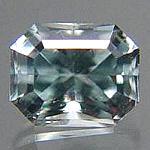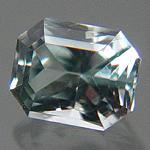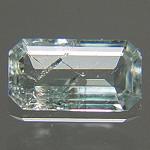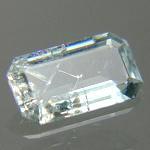|
|
|
Click on a
letter above to view the list of gems. |
|
|
|
|
|
|
Baryte
is
named from the Greek word baryos, meaning heavy
or weight,
due to its unusually high specific gravity for a non-metallic
mineral.
| | Discovered
in 1640;
IMA
status: Valid (pre-IMA; Grandfathered) | |
|
|
Composition: |
Barium |
58.84 % |
Ba |
65.70 % |
BaO |
|
|
Sulfur |
13.74 % |
S |
34.30 % |
SO3 |
|
|
Oxygen |
27.42 % |
O |
|
|
|
|
|
100.00 % |
|
100.00 % |
= TOTAL OXIDE |
|
|
|
|
Classification
|
|
|
|
|
Mineral
Classification: |
Sulfates
|
|
Strunz 8th
Ed. ID:
|
6/A.09-20
|
|
Nickel-Strunz 10th
Ed. ID:
|
7.AD.35
|
|
|
7 : SULFATES (selenates, tellurates, chromates, molybdates,
wolframates)
A : Sulfates (selenates, etc.) without additional anions,
without H2O
D : With only large cations
|
|
Related
to: |
Barite
Group. Baryte-Celestine
Series. The barium analogue of Celestine.
|
|
Members
of Group: |
Barite
Group: Anglesite, Barite, Celestine, Hashemite
|
|
Varieties: |
Angleso-barite,
Baryte Rose, Ca- and Sr-rich Baryte, Calcareobarite,
Celestobarite (of Dana), Hokutolite, Meißelspat, Oakstone,
Radian Barite, Schoharite, Strontian Barite, Strontian Baryte
|
|
Synonyms: |
Astapia,
Astrapia, Baritite, Baryte, Baroite, Baroselenite, Barote,
Barytes, Barytine, Barytite, Bologna stone, Bolognian Spar,
Bononian stone, Boulanite, Boulonite, Calk, Calstronbarite,
Cauk, Cawk, Dreelite, Dréelite, Fetid Heavy Spar, Heavy Spar,
Tiff, Volnye, Yellow Spar
|
|
|
|
|
Crystal
Data
|
|
|
|
|
Crystallography:
|
Orthorhombic
- Dipyramidal
|
|
Crystal
Habit:
|
Commonly
in well-formed crystals, to 85 cm, with over 70 forms
noted. Thin to thick tabular; also prismatic, equant.
As crested to rosettelike aggregates of tabular individuals,
concretionary, fibrous, nodular, stalactitic, may be
banded; granular, earthy, massive.
|
|
Twinning:
|
None
|
|
|
|
|
Physical
Properties
|
|
|
|
|
Cleavage: |
Perfect
on {001}, less Perfect on {210}, Imperfect on {010}
|
|
Fracture: |
Irregular/Uneven
|
|
Tenacity:
|
Brittle
|
|
Moh's
Hardness: |
3.0
- 3.5
|
|
Density:
|
4.48
- 4.50 (g/cm3)
(very heavy for a non-metallic mineral)
|
|
Luminescence:
|
May fluoresce in
shades of yellow or white (Franklin & Sterling Hill, NJ),
occasionally orange or pink under LW UV and phosphoresce
cream or strongly greenish-white to spectral colors under UV.
May
be thermoluminescent at times. |
|
Radioactivity:
|
Not
Radioactive
|
|
Other: |
Slightly
soluble in water, more so in solutions of salts
or acids.
Diamagnetic. |
|
|
|
|
Optical
Properties
|
|
|
|
|
Color: |
Colorless,
White, Yellow, Brown, Gray, pale shades of Red, Green,
Blue, may be zoned, or change color on exposure to light
|
|
Transparency: |
Transparent
to Translucent to Opaque
|
|
Luster: |
Vitreous,
Pearly
|
|
Refractive
Index: |
1.634
- 1.648 Biaxial ( + )
|
|
Birefringence: |
0.0110 - 0.0120
|
|
Dispersion: |
Weak;
r > v |
|
Pleochroism: |
Weak;
Color X Y Z
Brown: Straw-yellow Wine-yellow Violet
Yellow: Lt. yel.-brn. Yellow-brn Brown
Green: Nr colourless Lt. grn. Amethyst
Blue-grn: Blue-violet Bluish grn Violet
|
|
|
|
|
Occurances
|
|
|
|
|
Geological
Setting: |
Commonly found as a gangue mineral in metallic ore deposits of epithermal or
mesothermal origin; but it may also be found as lenses or replacement deposits
in sedimentary rocks, both of hypogene and supergene origin. |
|
Common
Associations: |
Calcite,
Dolomite, Fluorite, Galena, Magnatite, Pyrite, Quartz,
Siderite |
|
Common
Impurities: |
Sr,
Ca, Pb |
|
Type
Locality: |
n/a
|
|
Year
Discovered: |
1640
|
|
View
mineral photos: |
Barite
Mineral Photos and Locations |
|
|
|
|
More
Information
|
|
|
|
|
|
Mindat.org
Webmineral.com
|
|
|
|
|
Barite (also
spelled Baryte) is a fairly common mineral but somewhat rare as
a gemstone because
clean, facet grade crystals are difficult to find.
Barite (BaSO4) is the most common barium mineral and is the
barium analog of Celestine
(Celestite) (SrSO4). Celestine
contains strontium (Sr) in place of Barite's barium
(Ba). Both have the same structure and can form very similar
crystals. Barite is a member
of the Barite mineral group that also includes Anglesite
and
Celestine. Barite crystals are usually found as opaque masses or opaque bladed crystals.
Transparent crystal specimens can be found in some
locations. One example are the blue crystals found at Stoneham, Weld
County, Colorado, USA.
Barite is
unusual in that it is a diamagnetic mineral. Diamagnetism
is a form of magnetism where certain minerals are repelled
by an externally applied magnetic field, and form internal
induced magnetic
fields in the direction opposite to that of the applied magnetic field. In contrast
with this behavior, some minerals, such as Xenotime,
are paramagnetic. Paramagnetism is a form of magnetism where certain minerals are attracted by an externally applied magnetic field, and form internal, induced magnetic fields in the direction of the applied magnetic field.
Some
notable sources of
facetable crystals are Thunder Bay District, Ontario,
Canada (colorless); Rock Candy Mine, British Columbia,
Canada (yellow); Cumberland, England; and in the USA
from Meade County, South Dakota (brown); the Book Cliffs,
near Grand Junction, Colorado (colorless); and
Stoneham, Weld
County, Colorado (blue). There are many other locations
for Barite.
|
|
Barite
gems for sale:
|

|
|
Gem:
|
Barite |
|
Stock
#:
|
BAR-001 |
|
Weight:
|
0.8240
ct |
|
Size: |
5.19
x 4.15 x 3.52 mm |
|
Shape: |
Cut
Corner Rectangle, Radiant |
|
Color: |
Blue |
|
Clarity: |
Eye
Clean |
|
Origin: |
Stoneham,
Colorado, USA |
|
Treatment: |
None
(natural) |
|
Price: |
SOLD
(but we have others) |
|
Pictures
are of the actual gem offered for
sale.
Gem images are magnified to
show detail. |
|
|

|
|
A
very rare gem from
a classic Barite location; Stoneham,
Weld County, Colorado, USA. Probably
the best known location in the world
for blue Barite. This beautiful gem
was precision faceted in the US and
is eye clean and very bright. It was
very difficult to capture the beautiful,
almost baby blue color in this wonderful
gem.
|
|

|
|
Gem:
|
Barite |
|
Stock
#:
|
BAR-002 |
|
Weight:
|
0.8650
ct |
|
Size: |
7.54
x 4.22
x 1.99 mm |
|
Shape: |
Cut
Corner Rectangle, Step |
|
Color: |
Pale
Blue |
|
Clarity: |
Eye
Clean
- I2 |
|
Origin: |
Stoneham,
Colorado, USA |
|
Treatment: |
None
(natural) |
|
Price: |
SOLD
(but we have others) |
|
Pictures
are of the actual gem offered for
sale.
Gem images are magnified to
show detail. |
|
|

|
|
A
very rare gem from
a classic Barite location; Stoneham,
Weld County, Colorado, USA. Probably
the best known location in the world
for blue Barite. This gem has some inclusions
but still a very nice gem from a very
collectable Barite location.
|
|
|
